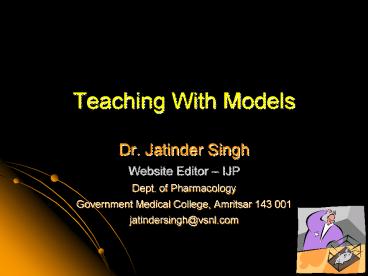Teaching With Models - PowerPoint PPT Presentation
1 / 19
Title:
Teaching With Models
Description:
Models enable different aspects of the system; objects, events, or ideas which ... Models can range from the downright simple to the more sophisticated ... – PowerPoint PPT presentation
Number of Views:27
Avg rating:3.0/5.0
Title: Teaching With Models
1
Teaching With Models
- Dr. Jatinder Singh
- Website Editor IJP
- Dept. of Pharmacology
- Government Medical College, Amritsar 143 001
- jatindersingh_at_vsnl.com
2
What is a Model?
- A model is a simplified representation of a
system, which concentrates attention on specific
aspects of the system. - Models enable different aspects of the system
objects, events, or ideas which are either
complex, or on a different scale to that which is
normally perceived, or is abstract. - These are rendered either visible or more readily
visible
3
Models
Physical Analog
Conceptual
Mathematical
Compare
Reality
Statistical
Visual
4
Physical Models
- Interactive physical models of systems can be
easily observed and manipulated and have
characteristics similar to key features of more
complex systems in the real world. - These models can help bridge the gap between
conceptual models and models of more complex real
world systems. - The most recognisable type of models.
5
Why Use Models?
- Provide an environment for interactive student
activity. - Enhance systems thinking abilities
- Models and model development are useful for
helping students learn quantitative skills such
as graphical analysis, visualization, statistics
and computational skills
6
- .evidence suggests that with the use of
activity based science programs, teachers can
expect substantially improved performances in
science processes - Bredderman, T. What Research Says
Activity Science - The Evidence Shows it
Matters, Science and Children (1982), 1, pp.
39-41.
7
Why Use Models? contd
- Model construction is a way of improving thinking
skills and enhance collaborative efforts. - Encourage logic, reasoning and creativity-all
assets to the scientific thought process. - An important reason to use a model is that one
can perform experiments without harming the
system of interest.
8
How to use Models-Technical aspects
- Acquiring the models or ideas in a useable form.
- Identification and use of the proper equipment
and components for physical models. - The models should possess a scope for
manipulating the modelling environment.
9
- Models can be used to introduce specific content.
- Models can be used to explore "What-if"
scenarios. - Models can be used explore the sensitivity of a
system to variations in its different components.
- Models can be used for evaluation during
examinations.
10
Decide on the purpose of the model
Modelling!
Collect information and data
Reject Conceptual Model
Produce a conceptual model
Consider scope and limitation of model
Modify conceptual model
Construct physical model
Design and perform tests
Test Failed
Test Passed
Purpose fulfilled
11
Validation
- Important aspect of the process.
- Done at two levels
- The conceptual model by undertaking a dry-run
- Validation of results of the test and analyzing
them for their corroboration with the real-life
purpose of the model. - Documentation of the process of making the model
should be done to ensure reproducibility.
12
- Successful modeling involves a clear perception
of - why a model is being produced.
- the audience that would make use of it.
- Construction of the model only requires
inexpensive materials, which can be found around
the classroom or purchased at scientific stores. - Above all - Simplicity
13
Examples
Please pass the cauliflower
- Models can range from the downright simple to the
more sophisticated
14
MODEL DEMONSTRATING CARDIOVASCULAR PRINCIPLES
15
- Model for intravenous injection
16
(No Transcript)
17
Model for IV Injection
- Objective - a model to teach IV injecting skills.
- External appearance - reasonably resembles a hand
and forearm - Texture - not very similar to skin
- Advantages
- Easy to make
- Can be reused
- Can be used for testing in OSPE
- Students can use for practice
18
Conclusion
- Models provide a supplement to traditional
teaching - The construction and subsequent manipulation of a
model demonstrates many important principles. - The model should be designed
- with clearly defined goals
- relevant content
- questions and answers
- all of these ensure a positive cooperative
learning experience for both students and
instructors.
19
(No Transcript)































